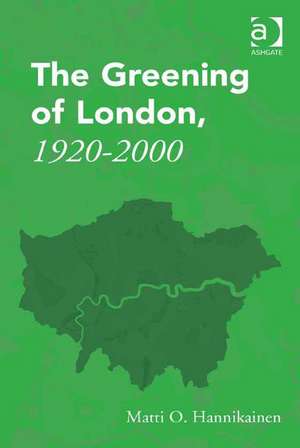The Greening of London, 1920–2000
Autor Matti O. Hannikainenen Limba Engleză Hardback – 9 dec 2015
| Toate formatele și edițiile | Preț | Express |
|---|---|---|
| Paperback (1) | 299.52 lei 6-8 săpt. | |
| Taylor & Francis – 16 iun 2017 | 299.52 lei 6-8 săpt. | |
| Hardback (1) | 824.17 lei 6-8 săpt. | |
| Taylor & Francis – 9 dec 2015 | 824.17 lei 6-8 săpt. |
Preț: 824.17 lei
Preț vechi: 1105.26 lei
-25% Nou
Puncte Express: 1236
Preț estimativ în valută:
157.73€ • 162.94$ • 131.27£
157.73€ • 162.94$ • 131.27£
Carte tipărită la comandă
Livrare economică 26 martie-09 aprilie
Preluare comenzi: 021 569.72.76
Specificații
ISBN-13: 9781472458155
ISBN-10: 147245815X
Pagini: 284
Dimensiuni: 156 x 234 x 24 mm
Greutate: 0.69 kg
Ediția:1
Editura: Taylor & Francis
Colecția Routledge
Locul publicării:Oxford, United Kingdom
ISBN-10: 147245815X
Pagini: 284
Dimensiuni: 156 x 234 x 24 mm
Greutate: 0.69 kg
Ediția:1
Editura: Taylor & Francis
Colecția Routledge
Locul publicării:Oxford, United Kingdom
Cuprins
Introduction. Part I Growing Interest in Greening: 1920-1939: Provision of public green space in inter-war London; Leisure in public green space. Part II Greening with New Plans and Powers: 1940-1965: Post-war greening of London; Leisure in post-war green space. Part III Fragmentation and Revival: 1965-1999: Dispersal of planning and provision; Decline of outdoor leisure. Conclusion: the greening of London; Bibliography; Index.
Notă biografică
Dr Matti O. Hannikainen studied history at the University of Helsinki, Finland, where he received his doctoral degree in 2014. He has worked extensively on the history of public green space in London as well as in Helsinki from the 19th century to the present. His research interests include urban history and environmental history. He is currently researching for a comparative history of the formation of modern metropolitan landscapes in the UK and in Germany during the late 20th century.
Recenzii
’Matti Hannikainen has done a fine job in providing what is the first planning history of London’s green spaces in the twentieth century. Skilfully researched and sharply written, it deserves the attention of all those interested in how green spaces survived and even thrived in the midst of Britain’s teeming metropolis.’ Simon Gunn, University of Leicester, UK 'As outdoor leisure declines, and open space becomes increasingly privatised, The Greening of London is a timely and important reminder that accessible open spaces and parklands were at the heart of the social history of London.' Mark Clapson, University of Westminster, UK 'A timely, innovative and very welcome record of an important subject. Deeply researched, this account makes a vital contribution to our understanding of where we are now in the fight to sustain green space in a major capital city.' Helen Meller, University of Nottingham, UK
Descriere
The long-term development of public green spaces in London during the twentieth century is a curiously neglected subject, despite the fact that various kinds of green spaces cover huge areas in cities. Building on case studies of the contemporary boroughs of Camden and Southwark and making use of a wealth of archival material, the author takes us through the planning and creation stages, to the intended uses and ongoing management of the spaces. It makes a crucial contribution to academic as well as political discourse on the history and present role of green space in sustainable cities.
